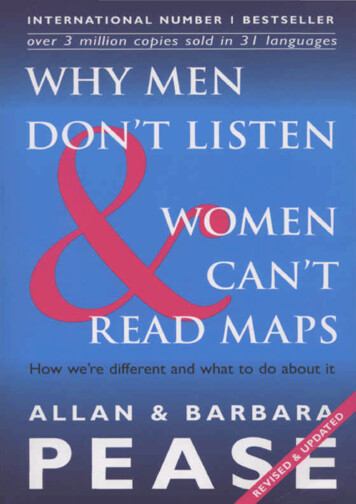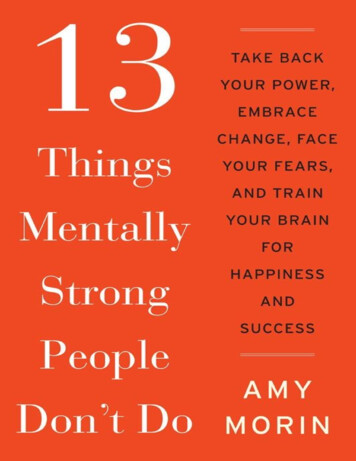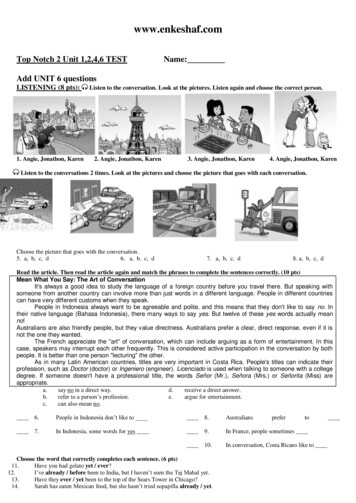
Transcription
1
WHY MENDON'T LISTEN&WOMEN CAN'TREAD MAPSBarbara & Allan Pease2
Copyright Allan Pease 2001All rights reservedThe right of Allan Pease to be identifiedas the author of this work has beenasserted by him in accordance with theCopyright, Designs and Patents Act 1988.This edition published in 2001 byPease International Pty LtdPhone: 61-7-5444 7000Fax: 61-7-5444 7550Email: info@peaseinternationalWeb: www. peaseinternational. comPublished in Great Britain byOrion Publishing GroupDistributed in Australia and New Zealandby HarperCollins LtdImported to Great Britain by Pease Training International Ltd.Tel: 01564 741 888 Fax: 01564 741 800Email: peaseuk@compuserve. comA CIP catalogue record for this bookis available from the British LibraryDesigned by Karen Stirling Printed by GriffinPress, NetleyISBN 0 957 81081 4Sc/PR JaBay3
CONTENTSAcknowledgmentsIntroduction 14A Sunday DriveWhy Writing This book Was So Tough1. Same Species, Different WorldsI9Some Things Are ObviousDifferent Job SpecsThe 'Stereotype' ArgumentIs it All a Male Conspiracy?Where We (the Authors) StandThe Nature Versus Nurture ArgumentYour Human GuidebookHow We Got This WayWe Didn't Expect it to Be Like ThisWhy Mum and Dad Can't HelpWe're Still Just Another Animal2. Making Perfect Sense 34Women as Radar DetectorsThe Eyes Have ItEyes in the Back of her Head?Why Womens' Eyes See So MuchThe Slippery Case of the Missing ButterMen and OglingSeeing is BelievingWhy Men Should Drive at Night4
Why Women Have a 'Sixth Sense'Why Men Can't Lie to WomenShe Hears Better Too.Women Read Between the LinesMen Can 'Hear' DirectionWhy Boys Don't ListenMen Miss the DetailsThe Magic of TouchWomen Are Touchy-FeelyWhy Men Are So Thick-SkinnedA Taste for LifeSomething in the AirThe X-PhilesWhy Men Are Called 'Insensitive'3. It's All In The Mind 57Why We're Smarter than the RestHow Our Brains Defend TerritoryThe Brains Behind SuccessWhat's Where in the BrainWhere Brain Research BeganHow the Brain is AnalysedWhy Women Are Better ConnectedWhy Men Can Only Do One Thing at a Time!Try the Toothbrush TestWhy We Are Who We AreProgramming the FoetusThe Brain-Wiring TestHow to Score the TestAnalysing the ResultA Final Word5
4. Talking And Listening 85The 'Blue or Gold Shoes' Strategy Why MalesCan't Talk ProperBoys and Their SchoolingWhy Women Are Great TalkersWhy Women Need to TalkThe Hormonal ConnectionWomen Love to TalkMen Talk Silently to ThemselvesThe Downside of Silent TalkWomen Think AloudThe Downside of Thinking AloudWomen Talk, Men Feel NaggedWhy Couples FailHow Men TalkWomen Multi-TrackWhat Brain Scans ShowStrategies for Talking with MenWhy Men Love Big WordsWomen Use Words for RewardWomen Are IndirectMen Are DirectWhat to Do About ItHow to Motivate a Man to ActionWomen Talk Emotively, Men Are LiteralHow Women ListenMen Listen Like StatuesHow to Use the GruntHow to Get a Man to ListenThe Schoolgirl Voice6
5. Spatial Ability: Maps, Targets And ParallelParking 118How a Map Almost Led to DivorceSexist ThinkingThe Lunch-Chaser in ActionWhy Men Know Where to GoWhy Boys Hang Out in Video ArcadesBoys' Brains Develop DifferentlyDiana and her FurnitureTesting Spatial AbilityHow Women Can NavigateWhat if You Can't Find North?The Flying MapThe Upside-Down MapA Final TestHow to Avoid an ArgumentHow to Argue While DrivingHow to Sell to a WomanThe Pain of Reverse Parallel ParkingWomen Are Safer DriversHow Women Were MisledSpatial Ability in EducationSpatial Skill OccupationsBilliards and Nuclear ScienceThe Computer IndustryMaths and AccountingAll Things Being Equal.Boys and their ToysHow Women FeelCan You Improve Your Spatial Skill?Some Useful StrategiesIn Summary7
6. Thoughts, Attitudes, Emotions And OtherDisaster Areas 149Our Different PerceptionsBoys Like Things, Girls Like PeopleBoys Compete, Girls Co-operateWhat We Talk AboutTalking DirtyWhat Modern Men and Women WantEmotion in the BrainWomen Value Relationships, Men Value WorkWhy Men 'Do Things'Why Men and Women Leave Each OtherWhy Men Hate to Be WrongWhy Men Hide Their EmotionsWhy Men Hang Out with the BoysWhy Men Hate AdviceWhy Men Offer SolutionsWhy Stressed Women TalkWhy Stressed Men Won't TalkUsing Spatials to Solve ProblemsWhy Men Flick the TV ChannelsHow to Get Boys to TalkWhen They're Both StressedThe Complete Shut-OutHow Men Alienate WomenWhy Men Can't Handle Women Being EmotionalThe Crying GameEating OutShopping: Her Joy, His TerrorHow to Give a Woman a Sincere Compliment8
7. Our Chemical Cocktail 176How Hormones Control Us TheChemicals of 'Falling in Love'Hormonal ChemistryWhy Blondes Have High Fertility PMTand Sex DriveWoman's Chemical GloomTestosterone: Bonus or Curse?The Case of the Flying Crockery WhyMen Are AggressiveWhy Men Work So Hard Testosteroneand Spatial Ability Why Women HateReverse Parking Mathematics andHormones Modern Man's HuntingWhy Men Have Pot Bellies and Women Have LargeRears8. Boys Will Be Boys, But Not AlwaysGays, Lesbians and TranssexualsHomosexuality is Part of HistoryIs it Genetic or a Choice?Why People Look to the FatherCan the 'Choice' Be Changed?The Case of Identical Gay TwinsIt's in their GenesThe 'Gay Gene'Gay Fingerprints and Family StudiesExperimental ChangesIt's What Happens in the WombThe Transsexual BrainAre We Slaves to Our Biology?Why Gay Men Aren't All AlikeLesbian Differences9197
9. Men, Women and Sex 216How Sex BeganWhere is Sex in the Brain?Why Men Can't Help ThemselvesWhy Women Are FaithfulMen Are Microwaves, Women Are Electric OvensWhy We Argue About SexSex Drive and StressHow Much Sex Are We Having?Sex on the BrainHow Sex Improves Your HealthMonogamy and PolygamyWhy Men Are PromiscuousThe Rooster EffectWhy Men Want Women to Dress Like Tarts(But Never in Public)Why Men Are Three-Minute WondersThe Ball GameBalls Have Brains TooMen and OglingWhat Men Need to DoWhat We Really Want, Long-TermWhy Men Want 'Just One Thing'Why Sex Suddenly StopsWhat Men Want From SexWhat Women Want From SexWhy Men Don't Talk During SexThe Orgasm ObjectiveWhat Turns Us On?How Men Get a Raw DealThe Aphrodisiac MythMen and their PornographyAre There Female Sex Maniacs?Lights Off or On?10
10. Marriage, Love And Romance 255Why Women Need MonogamyWhy Men Avoid CommitmentWhere is Love in the Brain?Love: Why Men Fall In and Women Fall OutWhy Men Can't Say 'I Love You'How Men Can Separate Love from SexWhen Women Make Love, Men Have SexWhy Great Partners Look AttractiveDo Opposites Attract?Physical Opposites AttractThe Hips-to-Waist Ratio is the KeyMen and RomanceSome Surefire Romance Tips for MenWhy Men Stop Touching and TalkingWhy Men Grope and Women Don'tIs There Love in Springtime?How to Think SexyRecreating InfatuationHow to Find the Right Partner11. Towards A Different Future 279What Do Men and Women Really Want?Occupational ChoicesThe Feminising of BusinessWhat To Do About BoysNo Role Models for BoysThe Sports HeroIs This All Politically Correct?Our Biology Hasn't Changed MuchFinally.References 29311
ACKNOWLEDGMENTSRay & Ruth Pease, Bill & Beat Suter, Alison & Mike Tilley,Jaci Elliott, Stella Brocklesby, Paula & Natasha Thompson,Michael Hedger, Christine Maher, Ray Martin, Dr RudiBrasch, Prof Stephen Dain, Christine Craigie, Dr ThemiGaragounas, Prof Dennis Burnham, Prof Barbara Gillham,Bryan Cockerill, Leanne Wilson, Geoff Arnold, LisaTierney, Robyn McCormick, Kerri-Anne Kennerley, GeoffBurch, Jonathan Norman, Marie Ricot, Julie Fenton, NickSymons, Richard & Linda Denny, Angela & Sheila WatsonChallis, Simon Howard, Tom Kenyon-Slaney, Tony &Patrica Earle, Darley Anderson, Sue Irvine, Leanne Christie,Anita & Dave Kite, Barry Toepher, Bert Newton, BrendanWalsh, Carrie Siipola, Debbie Tawse, Celia Barnes,Christina Peters, Hannelore Federspiel, David & JanGoodwin, Eunice & Ken Worden, Frank & Cavill Boggs,Graham & Tracey Dufty, Graham Shiels, Grant Sexton, KazLyons, Barry Markoff, Peter Rosetti, Max Hitchins, DebbieMehrtens, Jack & Valerie Collis, John Allanson, JohnHepworth, Pru Watts, Michael & Sue Rabbit, Michael &Sue Burnett, Michael & Kaye Goldring, Mike Schoettler,Peter & Jill Gosper, Rachel Jones, Ros & Simon Townsend,Sussan Hawryluk, Sue Williams, Terry & Tammy Butler, W.Mitchell, Walter Dickman, Bea Pullar, Alan Collinson,Russell Jeffery, Sandra & Loren Watts, Katrina Flynn, LukeCausby, Peter Draper, Scott Gilmour, Janet Gilmour, LisaPetrich, Geoff Weatherburn, Dawn Eccles-Simkins, DavidOrchard, Donn Guthrie, Chris Stewart, Howard Gibbs, SueMcIlwraith, Jules Di Maio, Nathan Haynes, Michael Kelly,Gary Larson, Dorie Simmonds and Trevor Dolby.12
13
INTRODUCTION14
a sunny Sunday afternoon as Bob and Sue setItoutwaswiththeir three teenage daughters on a lazydrive down to the beach. Bob was at the wheel and Suesat beside him, turning towards the back every fewminutes to join in the animated series of conversationsgoing on among their daughters. To Bob, it sounded asif they were all talking at once, creating an incessantbarrage of noise that just didn't make any sense at all.Eventually, he'd had enough.'Can you lot please shut up!' he yelled.There was a stunned silence.'Why?' asked Sue, eventually.'Because I'm trying to drive!' he replied, exasperated.The women looked at each other in completeconfusion. 'Trying to drive?' they mumbled.They could not see any connection between their conversation and his ability to drive. He couldn't understand why they were all speaking simultaneously,sometimes on different subjects, with none of themappearing to listen.Why couldn't they just keep quiet and let him concentrate on driving? Their talking had already causedhim to miss the last turn-off on the highway.The fundamental problem here is simple: men andwomen are different. Not better or worse - justdifferent. Scientists, anthropologists and sociobiologistshave known this for years, but they have also beenpainfully aware that to express this knowledge publiclyin such a politically correct world could turn them intosocial pariahs. Society today is determined to believe15
that men and women possess exactly the same skills,aptitudes and potentials - just as science, ironically, isbeginning to prove they are completely different.And where does this leave us? As a society, onextremely shaky ground. It's only by understanding thedifferences between men and women that we can reallystart building on our collective strengths - rather thanon our individual weaknesses. In this book, we seizeupon the enormous advances that have recently beenmade in human evolutionary science and show how thelessons learned apply to male and female relationships.The conclusions we unearth are controversial. They areconfronting. They are, occasionally, extremely disturbing. But they give us all a solid and thorough understanding of the many strange things that happenbetween men and women. If only Bob and Sue had readit before they had set out.Why Writing This Book Was So ToughThis book took us three years, and more than 400, 000kilometres, to write. In the course of our research, westudied papers, interviewed experts and gave seminarsthroughout Australia, New Zealand, Singapore,Thailand, Hong Kong, Malaysia, England, Scotland,Ireland, Italy, Greece, Germany, Holland, Spain, Turkey,the USA, South Africa, Botswana, Zimbabwe, Zambia,Namibia, Angola, Switzerland, Austria, Finland,Indonesia, Bulgaria, Saudi Arabia, Poland, Hungary,Borneo, Russia, Belgium, France, Japan and Canada.One of the most difficult tasks was getting public andprivate organisations to give their opinions on the facts.For example, fewer than 1% of all commercial airlinepilots are female. When we tried to discuss this withairline officials, many were too terrified to offer an16
opinion for fear of being accused of being sexist or antifemale. Many said 'no comment' and some organisations even made threats about their names beingmentioned in our book. Women executives weregenerally more obliging, although many took an immediately defensive position and saw this research as anattack on feminism without even knowing what it wasabout. Some of the authoritative opinions we havedocumented were obtained 'off the record' fromcorporate executives and university professors in dimlylit rooms, behind closed doors, with guarantees thatthey were not being quoted nor their organisationsnamed. Many had two opinions - their politicallycorrect public opinion and their real opinion, whichwas 'not to be quoted'.You will find this book sometimes challenging,sometimes startling, but always fascinating. While it isbased on hard scientific evidence, we have usedeveryday conversations, beliefs and scenarios that rangefrom the humorous to the downright hilarious to makesure it's fun to read. We have tried to boil all theevidence down into the simplest explanations while, atthe same time, avoiding oversimplification. Thisapproach makes the information easily accessible formost people, but can annoy others in the science worldwho would prefer to read a science journal. Ourobjective in writing this book is to help you learn moreabout both yourself and the opposite sex, so that yourinteraction and relationships can be more fulfilling,enjoyable and satisfying.One driving organisation measured gender differencesin reverse parking ability and did comparisons inseveral countries. Their results were so astounding thatwhen the report was released they were inundated withcomplaints that they were sexist and racist. The reportwas immediately withdrawn and locked away, never to17
be seen again, as it was clearly bad for business.We obtained a copy of this study and will discuss theresults but, for legal and ethical reasons, we can't revealthe source.This book is dedicated to all the men and women whohave ever sat up at 2am pulling their hair out as theyplead with their partners, 'But why don't you understand?' Relationships fail because men still don't understand why a woman can't be more like a man, andwomen expect their men to behave just like they do.Not only will this book help you come to grips with theopposite sex, it'll help you understand yourself. Andhow you can both lead happier, healthier and more harmonious lives as a result.Barbara and Allan Pease18
CHAPTER 1SAME SPECIES,DIFFERENT WORLDS19
en and women are different. Not better orworse - different. Just about the only thing theyhave in common is that they belong to the samespecies. They live in different worlds, with differentvalues and according to quite different sets of rules.Everyone knows this, but very few people, particularlymen, are willing to admit it. The truth, however, ismost definitely out there. Look at the evidence.Around 50% of marriages end in divorce in Westerncountries and most serious relationships stop short ofbecoming long-term. Men and women of every culture,creed and hue constantly argue over their partners'opinions, behaviour, attitudes and beliefs.MSome Things Are ObviousWhen a man goes to a toilet, he usually goes for onereason and one reason only. Women use toilets as sociallounges and therapy rooms. Women who go to a toiletas strangers can come out best friends and lifelongbuddies. But everyone would be instantly suspicious ofthe man who called out, 'Hey Frank, I'm going to thetoilet. You wanna come with me?'Men dominate TV remote controls and flick throughthe channels; women don't mind watching the commercials. Under pressure, men drink alcohol and invadeother countries; women eat chocolate and go shopping.Women criticise men for being insensitive, uncaring,not listening, not being warm and compassionate, not20
talking, not giving enough love, not being committed torelationships, wanting to have sex rather than makelove, turning the temperature down, and leaving thetoilet seat up.Men criticise women about their driving, for notbeing able to read street directories, for turning mapsupside down, for their lack of a sense of direction, fortalking too much without getting to the point, for notinitiating sex often enough, turning the temperature up,and for leaving the toilet seat down. Men can neverfind a pair of socks but their CDs are in alphabeticalorder. Women can always find the missing set ofcar keys, but rarely the most direct route to their destination. Men think they're the most sensible sex.Women know they are.How many men does it take tochange a roll of toilet paper?It's unknown. It's never happened.Men marvel at the way a woman can walk into a roomfull of people and give an instant commentary oneveryone; women can't believe men are so unobservant.Men are amazed how a woman can't see a red flashingoil light on the car dashboard but can spot a dirty sockin a dark corner 50 metres away. Women are bewildered by men who can consistently parallel park a carin a tight spot using a rear-view mirror, but can neverfind the G-spot.If a woman is out driving and gets lost, she'll stop andask for directions. To a man, this is a sign of weakness.He'll drive round in circles for hours, muttering thingslike, 'I've found a new way to get there' or 'I'm in thegeneral area' and 'Hey, I recognise that petrol station!'21
Different Job SpecsMen and women have evolved differently because theyhad to. Men hunted, women gathered. Men protected,women nurtured. As a result, their bodies and brainsevolved in completely different ways.As their bodies physically changed to adapt to theirspecific functions, so did their minds. Men grew tallerand stronger than most women, while their brainsdeveloped to suit their tasks. Women were mostlycontent for men to work away as they kept the cavefires burning, and their brains evolved to cope withtheir function in life.Over millions of years, the brain structuresof men and women thus continued to change indifferent ways. Now, we know the sexes process information differently. They think differently. They believedifferent things. They have different perceptions, priorities and behaviours.To pretend otherwise, is a recipe for heartache,confusion and disillusionment all your life.The 'Stereotype' ArgumentSince the late 1980s, there has been an explosion ofresearch into male and female differences and the wayboth the male and female brains work. For the firsttime ever, advanced computer brainscanning equipmenthas allowed us to see the brain operating 'live' and,with that peek into the vast landscape of the humanmind, provided us with many of the answers to thequestions about male and female differences. Theresearch discussed in this book has been collected fromstudies in scientific, medical, psychological and sociological studies and it all points clearly to one thing: All22
things are not equal; men and women are different. Formost of the 20th Century those differences wereexplained away by social conditioning; that is, we arewho we are because of our parents' and teachers'attitudes which, in turn, reflected the attitudes of theirsociety. Baby girls were dressed in pink and given dollsto play with; baby boys were dressed in blue and giventoy soldiers and football jerseys. Young girls werecuddled and touched while boys were thumped on theback and told not to cry. Until recently, it was believedthat when a baby was born its mind was a clean slateon which its teachers could write its choices and preferences. The biological evidence now available,however, shows a somewhat different picture of whywe think the way we do. It shows convincingly that itis our hormones and brain wiring that are largelyresponsible for our attitudes, preferences andbehaviour. This means that if boys and girls grew up ona deserted island with no organised society or parentsto guide them, girls would still cuddle, touch, makefriends and play with dolls, while boys would competementally and physically with each other and formgroups with a clear hierarchy.The wiring of our brain in the womb andthe effect of hormones will determinehow we think and behave.As you will see, the way our brains are wired and thehormones pulsing through our bodies are the twofactors that largely dictate, long before we are born,how we will think and behave. Our instincts are simplyour genes determining how our bodies will behave ingiven sets of circumstances.23
Is it All a Male Conspiracy?Since the 1960s a number of pressure groups have triedto persuade us to buck our biological legacy. Theyclaim that governments, religions and educationsystems have added up to nothing more than a plot bymen to suppress women, colluding to keep goodwomen down. Keeping women pregnant was a way ofcontrolling them even more.Certainly, historically, that's how it appears. But thequestion needs to be asked: If women and men areidentical, as these groups claim, how could men everhave achieved such total dominance over the world?The study of how the brain works now gives us manyanswers. We are not identical. Men and women shouldbe equal in terms of their opportunities to exercise theirfull potential, but they are definitely not identical intheir innate abilities. Whether men and women areequal is a political or moral question, but whether theyare identical is a scientific one.The equality of men and women is apolitical or moral issue; the essentialdifference is a scientific one.Those who resist the idea that our biology affects ourbehaviour often do so with the best of intentions - theyoppose sexism. But they are confused about the differencebetween equal and identical which are two completelydifferent issues. In this book, you will see how scienceconfirms that men and woman are profoundly differentboth physically and mentally. They are not the same.We have investigated the research of leading palaeontologists, ethnologists, psychologists, biologists and24
neuro scientists. The brain differences between womenand men are now clear, beyond all speculation,prejudice or reasonable doubt.When weighing up the differences between males andfemales discussed in this book, some people may say,'No, that's not like me, I don't do that!' Well, maybethey don't. But we are dealing here with average menand women, that is, how most men and women behavemost of the time, in most situations and for most of thepast. 'Average' means that if you are in a room full ofpeople you'll notice that men are bigger and taller thanwomen, in fact 7% taller and an average 8% bigger.The tallest or biggest person in the room may be awoman, but overall the men are bigger and taller thanthe women. In the Guinness Book of World Records2001, the biggest and tallest people have almost alwaysbeen men. The tallest human on record was RobertWadlow from Alton, Illinois who, in June 1940,measured 2. 72 metres (8 feet 11. 1 inches). The tallestperson in the year 2000 was Radhouane Charbib ofTunisia who stood 2. 35 metres (7 feet 8. 9 inches).History books are full of 'Big Johns' and 'Little Suzies'!This is not sexist. It's fact.Where We (the Authors) StandReading this book, some people may begin to feelsmug, arrogant or angry. This is because, to a greater orlesser extent, they are victims of idealistic philosophiesthat claim women and men are the same, so let's clarifyour position on this now. We, the authors, are writingthis book to help you develop and improve your relationships with both sexes. We believe that men andwomen should have equal opportunity to pursue acareer path in any field they choose and that equally25
qualified people should receive equal compensation forthe same effort.Difference is not the opposite of equality. Equalitymeans being free to choose to do the things we want todo and difference means that, as men or women, wemay not want to do the same things. We usually choosedifferent things off the same list.Our aim is to look objectively at male and femalerelationships, explain the history, meanings and implications involved and to develop techniques and strategies for a happier and more fulfilling way of life. Wewon't beat about the bush with suppositions, politicallycorrect cliches or scientific mumbo-jumbo. If somethinglooks like a duck, sounds like a duck, walks like aduck and there is enough evidence to prove it's aduck, then that's what we'll call it.The evidence presented here shows that the sexes areintrinsically inclined to behave in different ways. We arenot suggesting that either sex is bound to behave orshould behave in any particular way.The Nature Versus Nurture ArgumentMelissa gave birth to twins, a girl and a boy.Jasmine, she wrapped in a pink blanket, and Adam,in a blue one. Relatives brought soft fluffy toys asgifts for Jasmine, and a toy football and a tiny footballjersey for Adam. Everyone cooed and gooed and talkedsoftly to Jasmine, telling her she was pretty andgorgeous, but it was usually only the femalerelatives who picked her up and cuddled her. Whenthe male relatives visited, they focused mostly onAdam, speaking noticeably louder, poking his belly,bouncing him up and down and proposing a future asa football player.26
Such a scenario will be familiar to everyone. It does,however, raise the question: Is this adult behaviourcaused by our biology or is it learned behaviour that isperpetuated from generation to generation? Is it natureor nurture?For most of the 20th century, psychologists and sociologists believed most of our behaviour and preferenceswere learnt from our social conditioning and our environment. However, we know that nurturing is a learnedphenomenon - adoptive mothers, whether they arehuman or monkey, usually do a superb job of nurturingtheir infants. Scientists, on the other hand, have arguedthat biology, chemistry and hormones are largelyresponsible. Since 1990, there has been overwhelmingevidence to support this scientific view that we are bornwith much of our brain software already in place. Thefact that men were usually the hunters and women thenurturers even today dictates our behaviour, beliefs andpriorities. A major study at Harvard University showsthat we not only behave differently towards boy andgirl babies, we also use different words. To baby girlswe softly say, 'You're so sweet', 'You're a little sweetheart', 'You're a beautiful little girl' and to baby boyswe raise our voices and say, 'Hey, big boy!' and 'Wow,you're so strong!'Yet giving Barbie Dolls to girls and Action Men toboys does not create their behaviour; it simply exacerbates it. Similarly, the Harvard study found that adults'distinctive behaviour towards baby girls and boys onlyaccentuated the differences that already exist. Whenyou put a duck on a pond, it starts to swim. Lookbeneath the surface, and you'll see the duck has webbedfeet. If you analyse its brain, you'll find that it evolvedwith a 'swimming module' already in place. The pondis just where the duck happens to be at the time and isnot causing its behaviour.27
Research shows that we are more a product of ourbiology than the victims of social stereotypes. We aredifferent because our brain is wired differently. Thiscauses us to perceive the world in different ways andhave different values and priorities. Not better or worse different.Your Human GuidebookThis book is like a guidebook to visit a foreign cultureor country. It contains local slang and phrases, bodylanguage signals and an insight into why the inhabitants are the way they are.Most tourists travel to foreign countries withouthaving done much local research and become intimidatedor critical because the locals won't speak English or cookburgers and chips. But to enjoy and benefit from theexperience of another culture you must first understandits history and evolution. Then you need to learn basicphrases and to sample their lifestyle for first hand experience and a deeper appreciation of that culture. Thatway you won't look, sound and act like a tourist - thekind of person who would have benefited just as muchfrom staying at home and merely thinking of other lands.This book will show you how to enjoy and benefitfrom the knowledge of the opposite sex. But first youmust understand their history and evolution.On a visit to Windsor Castle,an American tourist was heard to say,'It's a wonderful castle, but why didthey build it so close to the airport?'28
This book deals in facts and reality. It's about realpeople, authentic research, actual events and recordedconversations. And you don't need to worry aboutdendrites, corpus callosum, neuropeptides, magneticresonance imaging and serotonin in researching brainfunction. We did, but we're now keeping everything assimple as possible to make it easy to read. We deallargely with a relatively recent science called sociobiology - the study of how behaviour is explained by ourgenes and our evolution.You will discover a powerful set of concepts, techniques and strategies that are scientifically substantiatedand appear, for the most part, to be obvious orcommon sense. We've cast aside all techniques,practices or opinions that aren't grounded in, or provenby, science.We deal here with the modern naked ape - the apewho controls the world with mega-computers and canland on Mars, and who can still be traced directly backto a fish. Millions of years was spent developing us as aspecies, yet today, we are thrust into a technological,politically correct world that makes little or noallowance for our biology.It took us nearly 100 million years to evolve intoa society sophisticated enough to put a man on themoon, but he still had to go to the toilet like hisprimitive ancestors when he got there. Humans maylook a little different from one culture to another but,underneath, our biological needs and urges are thesame. We will demonstrate how our different behavioural traits are inherited or passed on from generationto generation and, as you will see, there are practicallyno cultural differences.Let's now take a brief look at how our brain evolved.29
How We Got This WayOnce upon a time, a long, long time ago, men andwomen lived happily together and worked in harmony.The man would venture out each day into a hostile anddangerous world to ris
Women Talk Emotively, Men Are Literal How Women Listen Men Listen Like Statues How to Use the Grunt How to Get a Man to Listen The Schoolgirl Voice. 7 5. Spatial Ability: Maps, Targets And Parallel Parking 118 How a Map Al










